April 28, 2014
Internet Security
This week we learned about the security of online activity. The guest speaker’s bottom line was that any information stored by a device that connects to the internet can, and has already been seen by a bad guy. What I gather that means is that no information can ever be completely secure. The security built into on line sites, the antivirus software we install on our computers, all the software that we use is written by humans, and so will likely have errors in it. People who have nefarious intentions can find these errors and exploit them to get to your information. Passwords are very important. It is key that you have different passwords for different accounts and to make each password longer than 10 characters. When your password has more than 10 characters, it becomes increasingly difficult to crack.
Our online presence creates data. This data can be tracked and used by both private organizations and the government. This data can be used in a variety of different manners. For example, private organizations like Facebook, and Google can use this data to target advertisements to you in particular. Governments can also use this data. They can use it to try to track demographics.
Final Project:
For my final project, I have created two bar graphs. They illustrate the increase of crime that occurred in DC. This increase of crime coincides with the increase of drug use. What was most interesting was the sharp increase of murders that also coincides with the increase of drug use. Both graphs can be seen below:
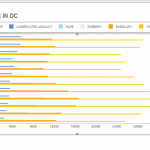
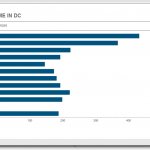
I am still having trouble finding a variety of primary sources and statistics. Most statistics started to be kept after 1991, when the nation became acutely aware and interested in how crack was taking over cities throughout the country. This obviously falls out of the 25 year time frame that has to go by for something to be considered history.
April 9, 2014
I learned to use tools to analyze text utilizing Voyant, Wordle, and Google Ngram. Each help you analyze bodies of text in different ways, but all three create visual pieces of the text being anayled.
Wordle
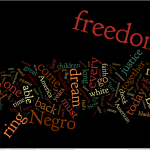
I found Martin Luther King, Jr.’s “I Have a Dream” speech, copied and pasted it in Wordle. It created an image of all the words used frequently in the speech; the size of the word was dependent on the frequency of its use. The some of the most frequently used words in MLK’s speech were freedom, negro, nation, and dream. This tool is useful only if you are already familiar with the text you are researching. If you are not, the frequency of the words being used does not tell you much without the context in which they are being used. When analyzing a piece of text for a web page, or a blog, this could be helpful to drive your analysis of the text to the reader. It could be a good tool to highlight your key points.
Voyant
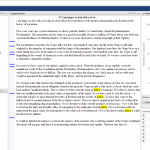
Voyant is very similar to Wordle. You can copy and paste a body of text into their website. It will then generate an image to represent the most frequently used words in the text. It also places the original text on the product. The negative to this site was that it does not automatically ignore words like the, and of. The positive on this website is that you can select words and it will highlight when those words are used in the text, and it will also create a graph to show you when the frequency of the selected word increases and decreases. This would be helpful in analyzing text when trying to see when a certain message was being portrayed. Like Wordle, this will only help you analyze text when you are already pretty familiar with it. You would not really be able to get text you are completely unfamiliar with and analyze it well using this site.
Google Ngram
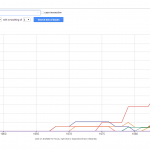
Google Ngram allows you to search for key words you are interested in. Google then searches its vast library of books for those key words and makes a graph for you. The graph will show you the frequency of use for your key words throughout a given time frame that can be changed. I searched for “crack cocaine followed by any verb. My time frame was from 1950 to 1989. The useful part of this software is that it links to books that can be used to further your research. The actual graph is does not tell you much more than frequency. If you started here, it could help you find the appropriate time range for you research project, which would be very helpful.
Final Project
I was able to find new primary sources for my final project this week. These sources gave me ideas for new key words that led me to a very useful crime database. I was also able to add new items that I found for my Omeka site. I started creating my exhibit.
April 4, 2014
 This week, I created a map using Google. I added two layers. The first layer was added using Google’s spreadsheet software. I added four points, two depicting areas where crack was sold, one indicating a location where two young men were murdered, and one addressing President Bush’s anti-drug speech. The second layer showed two areas. The first, smaller, area was a place where crack was sold in extremely large quantities, and the second was a neighborhood that stood up and took actions against the drug dealers and addicts. The tools available on Google were relatively easy to use. One difficulty, or annoyance, I ran into was in importing data. I originally made a spreadsheet using two points. I added photos to both points once I uploaded them on my map. I went back to my spreadsheet and added two more points. I couldn’t just update it on the map, I had to add a new layer, upload the updated spreadsheet, and find and attach the photos to the first two points again. It was not difficult to do, as only two points had to be re done, but this could get difficult if more points were already added. Creating this map gave me a greater insight on this topic. It gave me ideas for new search phrases. I was able to find more primary sources using these new phrases. I was also able to find information about the Shaw neighborhood, where an activist named Leroy Thorpe, Jr. led his neighbors in kicking the dealers and addicts out of their neighborhood.
This week, I created a map using Google. I added two layers. The first layer was added using Google’s spreadsheet software. I added four points, two depicting areas where crack was sold, one indicating a location where two young men were murdered, and one addressing President Bush’s anti-drug speech. The second layer showed two areas. The first, smaller, area was a place where crack was sold in extremely large quantities, and the second was a neighborhood that stood up and took actions against the drug dealers and addicts. The tools available on Google were relatively easy to use. One difficulty, or annoyance, I ran into was in importing data. I originally made a spreadsheet using two points. I added photos to both points once I uploaded them on my map. I went back to my spreadsheet and added two more points. I couldn’t just update it on the map, I had to add a new layer, upload the updated spreadsheet, and find and attach the photos to the first two points again. It was not difficult to do, as only two points had to be re done, but this could get difficult if more points were already added. Creating this map gave me a greater insight on this topic. It gave me ideas for new search phrases. I was able to find more primary sources using these new phrases. I was also able to find information about the Shaw neighborhood, where an activist named Leroy Thorpe, Jr. led his neighbors in kicking the dealers and addicts out of their neighborhood.
February 10, 2014
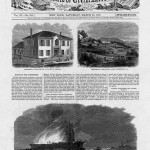 When I was searching for two primary sources that taught about the history of Washington D.C.,I located a map, Bird’s-eye-view of Washington City, D.C., and a newspaper article, Schools for Freedmen. I will discuss both below. “Bird’s-eye-view of Washington City, D.C.” is a map drawn by George A. Morrison in 1872 and was published by W.H. & O.H. Morrison. The map, located at the Library of Congress, depicts a “bird’s-eye-view” of the Washington DC, with the Capitol building being the dominant landmark. The map is not drawn to scale and depicts what the District looked like at the time. Close Analysis of the map shows that it includes a legend which identifies land marks such as the Botanical Gardens, the Smithsonian, the newly completed Washington Monument, the Potomac, and Georgetown University, among others. While researching the map and its author, I found it appeared in the 1876 edition of “Morrison’s Stranger’s Guide for Washington City.” Based on this, this map was probably drawn to help tourists find their way throughout the Capital. I researched the map, Morrison, and the book it was published in, but failed to find anything more.
When I was searching for two primary sources that taught about the history of Washington D.C.,I located a map, Bird’s-eye-view of Washington City, D.C., and a newspaper article, Schools for Freedmen. I will discuss both below. “Bird’s-eye-view of Washington City, D.C.” is a map drawn by George A. Morrison in 1872 and was published by W.H. & O.H. Morrison. The map, located at the Library of Congress, depicts a “bird’s-eye-view” of the Washington DC, with the Capitol building being the dominant landmark. The map is not drawn to scale and depicts what the District looked like at the time. Close Analysis of the map shows that it includes a legend which identifies land marks such as the Botanical Gardens, the Smithsonian, the newly completed Washington Monument, the Potomac, and Georgetown University, among others. While researching the map and its author, I found it appeared in the 1876 edition of “Morrison’s Stranger’s Guide for Washington City.” Based on this, this map was probably drawn to help tourists find their way throughout the Capital. I researched the map, Morrison, and the book it was published in, but failed to find anything more.
“Schools for Freedmen,” (pictured on the upper left corner) is an article written in the newspaper, Harper’s Weekly, on 30 March, 1867. According to the New York Public Library, this newspaper was an illustrated magazine which covered politics, the military, and cultural stories. The article did not include a byline. The author wrote how the newly “freedmen” of the south had begun to make strong efforts to educate their children. The author speaks of schools being built. It highlights a school that was built near Washington DC whose dual purpose was to provide primary education while simultaneously training the children to farm. With that aim, the school was built on a farm of one hundred acres. A picture of the farm was also included in the article. The author had an obvious favorable bias on the situation. Other websites, such as npr.gov, verify that schools for former slaves were built in or near DC. Further research showed that many great schools for African Americans were built in DC, schools including Howard University. Both sources were difficult to work with. This was probably due to their age. I tried searching for more information to further contextualize, or corroborate the information found, but I was not able to find much.
February 3, 2014
American Originals Part II
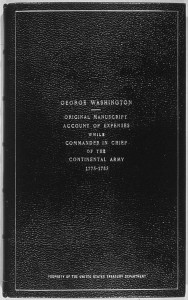 American Originals Part II is a website which presents some of the most important original documents in U.S. History. Documents such as General Lee’s demand for surrender. The documents are example of those stored by the National Archives and Records Administration. The web page organizes the documents chronologically and categorically. The pages include images and summaries of the documents along background information.
American Originals Part II is a website which presents some of the most important original documents in U.S. History. Documents such as General Lee’s demand for surrender. The documents are example of those stored by the National Archives and Records Administration. The web page organizes the documents chronologically and categorically. The pages include images and summaries of the documents along background information.
The website is extremely easy to navigate. The homepage contains links to all of its information in an easy to navigate format. The web page was made in order to entice a general audience to be interested in the National Archives. The most interesting part of the website are the images of the original documents. Reading the original documents gives the reader an intimate view of history. The website does not take full advantage of the technology available. It has not been updated since 1 July, 1998.
Digital History
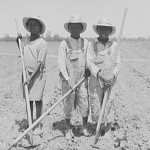 Digital History is a website which presents the history of the United States. The website’s historical content was created by Steven Mintz, a director form the Columbia University using a wide variety of sources such as text books, primary sources, essays and films. It is presented by the University of Utah. I found this website to be credible.
Digital History is a website which presents the history of the United States. The website’s historical content was created by Steven Mintz, a director form the Columbia University using a wide variety of sources such as text books, primary sources, essays and films. It is presented by the University of Utah. I found this website to be credible.
The website is easily navigated. It is organized chronologically from the arrival of the first people to America to the 21st century. The information is further organized into categories, such as people, events, and music, through the use of tabs. I found this method of organization helpful. I could pick a time frame, such as the Great Depression, and learn about it navigating the different tabs. It even provides links to other sites that contains useful information about the topic. While the website quotes primary historical documents, it does not have images of those original documents. It appears that the website was written for students and any audience interested in American History.
Both websites are easily navigated, credible and useful. They are both clearly written and can be used for interest as well as research.
January 27, 2014
Parking at Mason
Parking is not ideal at Mason. I got used to the small campuses that NVCC consisted of. I would enjoy the walking if it were not for the cold and snow. Here is a hyper link to YouTube.









